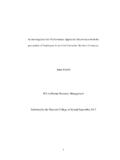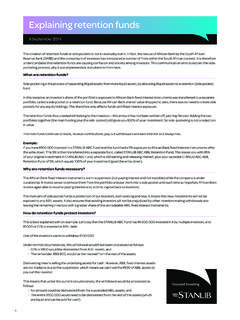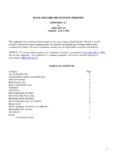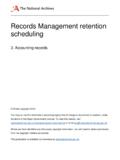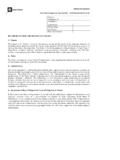Transcription of An Investigation into the Impact of Leadership …
1 I An Investigation into the Impact of Leadership Styles on Employee retention : Identifying which Leadership Style best encourages Employee retention in the Nigerian Banking Sector. A Case study of Zenith Bank Plc., Nigeria ADEDAMOLA ADEKANBI FAVOUR MA IN HUMAN RESOURCE MANAGEMENT NATIONAL COLLEGE OF IRELAND SUBMITTED TO THE NATIONAL COLLEGE OF IRELAND, AUGUST, 2016 ii Abstract An Investigation into the Impact of Leadership Styles on Employee retention : Identifying which Leadership Style best encourages Employee retention in the Nigerian Banking Sector. A Case study of Zenith Bank Plc, Nigeria Adedamola Adekanbi Favour Employee retention is a major concern of the Nigerian banking sector today because of increased employee turnover. This can be said to be as a result of the series of banking reforms, mergers and acquisition of banks, loss of job commitment and low employee morale.
2 The Nigerian banking sector is a strategic sector in the economy of the nation which drives the country s economy; however, the challenges being faced in the banking sector will not only affect the banks but can have an adverse effect on the economy of Nigeria if employee retention strategies are not put in place. This study was therefore designed to investigate the Impact of Leadership style on employee retention in the Nigerian banking sector. More so, it was aimed at identifying the Leadership style that best encourages employee retention in the Nigerian bank, with particular emphasis on the transformational and the transactional Leadership styles. The primary data for this study was collected through questionnaires and analysed using the Statistical Package for Social sciences (SPSS). Data was collected through both open ended and close ended questions with a five point Likert scale.
3 The study used the purposive, snowball and convenience sampling technique in order to get response from the respondents. The study revealed that Leadership style has a moderate significance on employee retention and that the transactional Leadership style best encourages employee retention in the Nigerian Banking sector. The study recommends that leaders and managers should properly implement the exchange process of the transactional Leadership style to mitigate employee turnover in the Nigerian banking sector iii Declaration Submission of thesis and dissertation National College of Ireland Research student declaration form (Thesis/author declaration form) Name: Adedamola Adekanbi Student number: 15002667 Award for which thesis is submitted: MA HRM Supervisor: Thomas McCabe Material submitted for award: a) I declare that the work has been composed by me. b) I declare that all verbatim extracts contained in the thesis have been distinguished by quotation marks and the sources of information have been specifically acknowledged.
4 C) My thesis will be included in electronic format in the college institutional repository TRAP( thesis reports and projects) d) Either *I declare that no material contained in the thesis has been used in any other submission for academic award. Or *I declare that the following material in the thesis formed part of a submission for the award of (State the awarding body) Signature of research student: Date: iv Acknowledgements I would like to thank God Almighty for helping me through this master s study. I couldn t have done this without the Grace of God. I would like to say a very big thank you to my supervisor, Thomas McCabe for all his guidance and advice towards the completion of this thesis. I would like to say a very big thank you to all the academic staff of National College of Ireland who have helped and been supportive to me through this studies and I would like to specially thank Keith Brittle for all his supports, guidance and assistance.
5 You have always been there to help me with my academic work. Thank you very much. I would like to thank everyone who took out time to participate in the survey for this study. Also I would like to say a very special thank you to my family, friends and classmates for their supports and encouragements particularly, Chika, Adeleke, Victoria, Sosa, Nonye, Arpita, Robinson, Wunmi, Dolapo, Bisi, Folake and Gbemisola. Thank you very much. Finally, I dedicate this thesis to my Parents, Mr and Mrs Bolaji. Thank you for all your encouragements, constant supports and making this a reality for me. Thank you so much and God bless you. Also to my siblings Dipo, Joseph, Obafemi, Ayo and Iyanu, thank you all for your supports. v List of Tables Table 1-2: Scale Case Summary and 35 Table 3-6: Scale case summary and 36 Table 7-8: Scale Summary and 37 Table 9: Gender Employee retention Sample 38 Table 11: Employee retention Normality 39 Table 12-13: Mann-Whitney Test and Grouping Variable: 39 Table 14: Age Employee retention sample 40 Table 16: Age Employee retention Normality Result.
6 41 Table 17-18: Kruskal-Wallis H test and Grouping Variable 42 Table 19: Marital Status retention 42 Table 21: Employee retention marital status 43 Table 22-23: Mann-Whitney Test and Grouping Variable: Marital 44 Table 24-25: Pearson Correlation Results and 45 Table 27-28: Pearson Correlation Result and 46 Table 30-31: Pearson Correlation Result and 47 Table 33: Pearson Correlation Result .. 48 vi List of Figures Figure 1-2: Employee retention Gender Sample 38 Figure 3-4: Employee retention Age Sample 40 Figure 5: Employee retention Age Sample 41 Figure 6-7: Employee retention Marital Status Sample 43 Figure 8: Other Factors Employee retention ..74 vii Table of Contents Abstract .. ii iii Acknowledgements .. iv List of Tables .. v List of Figures .. vi Table of Contents .. vii SECTION ONE: 1 Introduction .. 1 Research .. 2 Research Objectives.. 2 Purpose of the Study.
7 3 Research Structure .. 3 Background of the Nigerian Banking industry .. 4 SECTION TWO: LITERATURE REVIEW .. 5 Introduction .. 5 Employee retention and the Nigerian banking sector .. 5 What is Leadership ? .. 7 Leadership style .. 8 Styles of Leadership .. 9 Traditional Leadership styles .. 10 Bureaucratic Leadership style .. 10 Laissez- Faire Leadership style .. 10 Charismatic Leadership style .. 11 Democratic Leadership style .. 11 New Leadership Style .. 12 Transformational Leadership style .. 12 Transactional Leadership .. 14 Employee retention .. 16 Summary .. 19 SECTION THREE: RESEARCH QUESTIONS AND HYPOTHESIS .. 20 viii SECTION FOUR: METHODOLOGY .. 23 Introduction .. 23 Research philosophy .. 24 Procedure .. 25 Survey methodology .. 25 Justification of the 26 Population of the study .. 26 Sample technique .. 26 Sample details .. 27 Data collection.
8 28 Survey Structure .. 28 Survey 30 Advantages and disadvantages of Data collection method .. 30 Ethical consideration .. 31 Limitations .. 32 Company Profile .. 33 Zenith Bank Plc.. 33 SECTION FIVE: RESULT AND ANALYSIS .. 34 Introduction .. 34 Scale Reliability Results .. 34 Leadership Scale Reliability results .. 34 Transformational Leadership Style Scale Reliability results .. 35 Transactional Leadership Style Scale Reliability results .. 35 Employee retention Scale Reliability results .. 36 Employee retention and 36 Employee retention and Gender differences .. 37 Employee retention and Age Differences.. 39 Employee retention and Marital Status .. 41 Correlation Results .. 43 Leadership and Employee retention .. 43 Transformational Leadership Style and Employee retention .. 44 Transactional Leadership style and employee retention .. 45 Transactional and Transformational Leadership style with Employee retention .
9 46 Summary .. 48 ix SECTION 6: DISCUSSION AND 49 Introduction .. 49 Research Objectives .. 49 Research Result .. 50 Summary .. 52 SECTION SEVEN: CONCLUSION AND RECOMMENDATIONS .. 52 Introduction .. 52 Recommendation and Implication for further research .. 53 Personal Learning statement .. 53 REFERENCES .. 55 APPENDIX A .. 66 APPENDIX B .. 71 1 SECTION ONE: INTRODUCTION Introduction In today s rapidly changing environment, retention of employees has become one of the major concerns for organisations. This is because of the high rate of employee turnover in organisations especially in the banking sector, which has made banks continually struggle to put in place strategies to mitigate this turnover (Asrar-ul-Haq and Kuchinke, 2016). Getting the right employees into an organisation may be challenging, however, the retention of employees has become much more challenging to organisations (Chitra, 2013).
10 This challenge can be said to be as a result of the indirect and direct Impact the turnover of employees has on the organisation. People often have been said to leave their bosses and not necessarily their jobs (Harvey, Stoner, Hochwarter and Kacmar, 2007) which emphasizes the relevance of Leadership style on the retention of employees in organisations. In an attempt for organisations to mitigate employee turnover, Leadership style has become one of the most important areas to consider for employee retention in organisations today (Asrar-ul-Haq and Kuchinke, 2016). The banking sector of any country is the key driver of its economy, according to Anderibom and Obute (2015); this is because the banking industry is the primary mover of the economy of any nation. No economic activity will be successful if there aren t adequate funds, the bulk of which are provided by the banking sector. This goes a long way to show the significance of banks and the banking sector to the economic growth of any nation.




